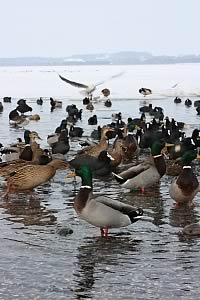2010-03-23
An international team of experts has warned that while more is known today about the role of wild birds in the spread of the highly pathogenic H5N1 avian influenza virus than ever before, significant information gaps remain unfilled as government and public attention is shifting elsewhere.
 |
"Waning attention to H5N1 HPAI is reducing surveillance and research opportunities, negatively affecting capacity building and coordination between environmental and agricultural authorities, and impacting efforts to further refine understanding of the epidemiology and the ecology of the virus," the Scientific Task Force on Avian Influenza and Wild Birds said in a statement following a review meeting held at FAO's Rome headquarters.
Established in 2005 and jointly led by FAO and the UNEP-Convention on Migratory Species, the task force is a collaborative partnership involving 15 international organizations, including several UN agencies, other intergovernmental groups, and specialist non-governmental organizations (see box at right).
"Unfortunately, H5N1 may have slipped off the radar screen for some people, but it continues to be a major problem, especially in Egypt and parts of Asia, where it is having a huge impact on food security and the livelihoods of farmers and local communities," said Juan Lubroth, FAO's Chief Veterinary Officer. H5N1 HPAI is has not been restricted to Asia alone, he added, having also occurred in Europe, Central Asia and parts of Africa.
In the past six months, there have been outbreaks of the virus in domestic poultry in Bangladesh, Cambodia, Romania, Israel, Myanmar, Nepal, Egypt, Indonesia, India, and Viet Nam and in wild birds in China, Mongolia, and the Russian Federation. Just this week, Bhutan reported outbreaks for the first time and the virus was detected after a three year absence in Romania in domestic poultry.
Poor farm biosecurity and trading of infected poultry are the main causes of disease spread. Wild birds play a much smaller role in the H5N1 HPAI ecology — but understanding their role in this disease, and managing the associated risks, poses particular challenges.
The disease has had great and varied conservation implications, including causing thousands of wild birds to die from viral exposure, inappropriate responses including culling of healthy wild birds and destruction of their habitats.
No smoking gun
Over the past five years some 750,000 healthy wild birds have been tested for the H5N1 HPAI virus worldwide, either by national authorities, NGO's, and international organizations like FAO.
Some expected that "wild reservoir" species — birds that can carry and spread the virus without getting sick — would turn up during this process.
So far that hasn't been the case. Only an extremely small number of apparently healthy infected wild birds have been found.
FAO has also led efforts to track over 500 migratory wildfowl in various regions with satellite transmitters in order to gather information on their movements and identify possible correlations with avian flu occurrences.
No smoking gun emerged from that effort.
This suggests that infection of domestic poultry from wild birds is rare and the risk to humans from wild birds is negligible. More testing is needed, however, to firm up this understanding.
"Seven-hundred and fifty thousand is a lot of birds, but when you consider the size of the global bird population, we may need to test even more birds if we are going to find the virus," explained Scott Newman, EMPRES Wildlife Unit Coordinator for FAO. "Is it that there's no wild bird reservoir, or that we have not sampled enough?"
"Certainly, wild birds have been involved in transmission in some cases, for example in Mongolia last year — and researchers in China recently reported finding the virus in apparently healthy wildfowl," said Newman.
These questions as well as other issues were discussed by the Task Force. Areas highlighted by the group as needing further improvement include:
- Standardisation of reporting and sampling methodologies to current best science-based practices;
- Continued and broader surveillance of wild bird populations, along with improving understanding of migration routes, habitat use, and movements;
- Strengthening of capacity do that those conducting outbreak investigations can evaluate the source of virus introduction;
- Education efforts to reduce indiscriminate blame of wild birds for outbreaks in poultry.
Fringe benefits for wildlife conservation
One of the side benefits of the unprecedented monitoring effort undertaken by FAO and its partners has been a wealth of new information regarding habitat use and migration patterns and routes of some species of wild birds.
"The data were generated so that we could better evaluate possible linkages between wild bird migrations and the occurrence of H5N1, but should prove a tremendous value in terms of identifying and prioritising wetlands of critical importance for conservation and management", said Newman.
No comments:
Post a Comment